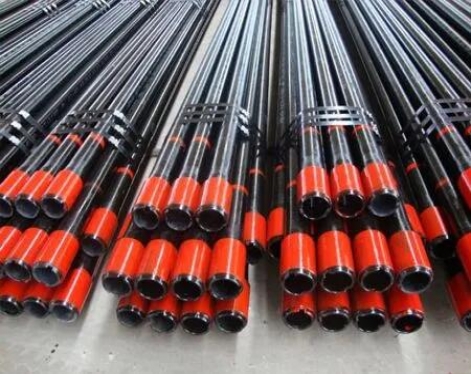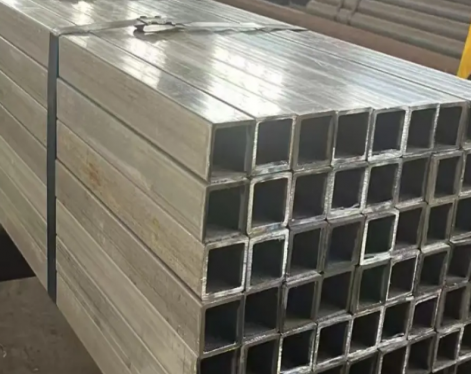Oil Country Tubular Goods (OCTG) and oil and gas pipelines (Line Pipe) are collectively referred to as oil country tubular goods. Oil country tubular goods are actually deep-processed products of steel pipes, including oil well pipes and oil and gas pipelines. Drill pipes, casings, oil tubing, drill collars, square drill pipes, etc. are collectively referred to as oil well pipes.
What is the function of oil tubing and casing pipe in oil wells? Which types of oil casings can be divided according to their different functions?
In oilfield drilling and production operations, "casing" refers to the pipe used to line the borehole, which prevents the wellbore from flowing or collapsing. It is a permanent part downhole, and the bottom of the casing is fixed with cement. Cement sometimes returns to the surface. Most casings have an outer diameter of 114.3mm or larger. The innermost pipe in the well is called tubing. Downhole fluid is sent to the surface through the tubing, which can be separated from the casing by a production separator. The tubing is often pulled out of the well and sometimes needs to be replaced. Most tubing has an outer diameter of 114.3mm or smaller.

The drilling environment often requires several layers of casing to reach the expected total well depth. Each layer of casing pipe can be divided into the following according to its different functions:
(1) Conduit. The outermost layer of the well, its main function is to reinforce the wellbore wall and prevent the surface gravel layer and unbonded rock from falling into the well.
(2) Structural pipe. Located between the guide tube and the surface pipe, the purpose of this layer of casing includes solving the problem of recurring leakage or well collapse and avoiding the problem of shallow gas well kick as much as possible.
(3) Surface casing. The purpose of the lower surface casing is multiple, including isolating the freshwater layer, preventing collapse and leakage, isolating the weak layer that cannot withstand the back pressure applied by controlling the well kick, providing conditions for installing blowout preventers, and supporting the weight of all layers of casing that are smaller than the surface casing.
(4) Intermediate casing. The main purpose is that high-pressure layers will be encountered during drilling, and high-density drilling fluid is needed to control abnormally high pressure. Shallow and weak formations must be protected to prevent leakage or stuck drill. In some special cases, intermediate casing is also used to isolate salt layers or expansive and easily collapsed shale layers.
(5) Liner. The liner has the same function as the intermediate casing. The liner extends from the bottom of the well upward into the intermediate casing, but does not extend to the ground. In order to save money, the liner does not need to extend the pipe string to the ground but can still achieve the purpose of controlling pressure and fracture gradient.
(6) Production casing. Also called oil layer casing. The function of this string is to separate the production layer from other formations, forming a working wellbore with a given diameter that can reach the production layer, and protecting the production oil pipe and equipment.
(7) Back-up pipe string. The liner is also often used as part of the production casing, instead of running another pipe string from the ground to the production layer. The liner can be returned to the ground from the top of the liner with an appropriate amount of pipe.
What is the steel grade of tubing and casing? What is the specific meaning of the expression?
In the API SPEC 5CT standard, the steel grade of casing and tubing indicates its yield strength and some special characteristics. The steel grade is usually indicated by 1 letter and 2 or 3 numbers, such as N80. In most cases, according to the order of the letters in the alphabet, the later the letters, the greater the yield strength of the pipe. For example, the yield strength of N80 grade steel is greater than that of J55.
The numerical symbol is determined by the minimum yield strength of the pipe expressed in thousands of pounds per square inch. For example: The minimum yield strength of N80 grade steel is 550Mpa.
According to the American Petroleum Institute standard API SPEC 5CT, there are 10 types of casing steel grades: H-40, J-55, K-55, N-80, C-75, L-80, C-90, C-95, P-110, and Q-125. Different well conditions and well depths require different steel grades. In corrosive environments, the casing itself is also required to have corrosion resistance. In places with complex geological conditions, the casing is also required to have anti-squeeze performance.
The casing should be supplied with threads and couplings, or supplied in any of the following pipe end forms: flat end, round thread without coupling or with coupling, trapezoidal thread with coupling or without coupling, direct connection thread, special end processing, sealing ring structure.
The important position of oil pipe:
The oil industry is an industry that uses a large number of oil pipes, and oil pipes occupy a very important position in the oil industry:
1. Oil pipes are used in large quantities and cost a lot, and there is great potential for saving expenses and reducing costs. The consumption of oil well pipe can be calculated based on the annual drilling measurement. According to the specific situation in my country, generally 62kg of oil well pipe is needed for every 1m of drilling, including 48kg of casing and 10kg of oil pipe. Drill pipe is 3kg and drill collar is 0.5kg;
2. The mechanical and environmental behavior of oil pipe has an important impact on the adoption of advanced technology and the increase of production and efficiency in the oil industry;
3. The failure loss of oil pipe is huge, and its safety, reliability and service life are of great importance to the oil industry.
What is the function of oil tubing and casing pipe in oil wells? Which types of oil casings can be divided according to their different functions?
In oilfield drilling and production operations, "casing" refers to the pipe used to line the borehole, which prevents the wellbore from flowing or collapsing. It is a permanent part downhole, and the bottom of the casing is fixed with cement. Cement sometimes returns to the surface. Most casings have an outer diameter of 114.3mm or larger. The innermost pipe in the well is called tubing. Downhole fluid is sent to the surface through the tubing, which can be separated from the casing by a production separator. The tubing is often pulled out of the well and sometimes needs to be replaced. Most tubing has an outer diameter of 114.3mm or smaller.

The drilling environment often requires several layers of casing to reach the expected total well depth. Each layer of casing pipe can be divided into the following according to its different functions:
(1) Conduit. The outermost layer of the well, its main function is to reinforce the wellbore wall and prevent the surface gravel layer and unbonded rock from falling into the well.
(2) Structural pipe. Located between the guide tube and the surface pipe, the purpose of this layer of casing includes solving the problem of recurring leakage or well collapse and avoiding the problem of shallow gas well kick as much as possible.
(3) Surface casing. The purpose of the lower surface casing is multiple, including isolating the freshwater layer, preventing collapse and leakage, isolating the weak layer that cannot withstand the back pressure applied by controlling the well kick, providing conditions for installing blowout preventers, and supporting the weight of all layers of casing that are smaller than the surface casing.
(4) Intermediate casing. The main purpose is that high-pressure layers will be encountered during drilling, and high-density drilling fluid is needed to control abnormally high pressure. Shallow and weak formations must be protected to prevent leakage or stuck drill. In some special cases, intermediate casing is also used to isolate salt layers or expansive and easily collapsed shale layers.
(5) Liner. The liner has the same function as the intermediate casing. The liner extends from the bottom of the well upward into the intermediate casing, but does not extend to the ground. In order to save money, the liner does not need to extend the pipe string to the ground but can still achieve the purpose of controlling pressure and fracture gradient.
(6) Production casing. Also called oil layer casing. The function of this string is to separate the production layer from other formations, forming a working wellbore with a given diameter that can reach the production layer, and protecting the production oil pipe and equipment.
(7) Back-up pipe string. The liner is also often used as part of the production casing, instead of running another pipe string from the ground to the production layer. The liner can be returned to the ground from the top of the liner with an appropriate amount of pipe.
What is the steel grade of tubing and casing? What is the specific meaning of the expression?
In the API SPEC 5CT standard, the steel grade of casing and tubing indicates its yield strength and some special characteristics. The steel grade is usually indicated by 1 letter and 2 or 3 numbers, such as N80. In most cases, according to the order of the letters in the alphabet, the later the letters, the greater the yield strength of the pipe. For example, the yield strength of N80 grade steel is greater than that of J55.
The numerical symbol is determined by the minimum yield strength of the pipe expressed in thousands of pounds per square inch. For example: The minimum yield strength of N80 grade steel is 550Mpa.
According to the American Petroleum Institute standard API SPEC 5CT, there are 10 types of casing steel grades: H-40, J-55, K-55, N-80, C-75, L-80, C-90, C-95, P-110, and Q-125. Different well conditions and well depths require different steel grades. In corrosive environments, the casing itself is also required to have corrosion resistance. In places with complex geological conditions, the casing is also required to have anti-squeeze performance.
The casing should be supplied with threads and couplings, or supplied in any of the following pipe end forms: flat end, round thread without coupling or with coupling, trapezoidal thread with coupling or without coupling, direct connection thread, special end processing, sealing ring structure.
The important position of oil pipe:
The oil industry is an industry that uses a large number of oil pipes, and oil pipes occupy a very important position in the oil industry:
1. Oil pipes are used in large quantities and cost a lot, and there is great potential for saving expenses and reducing costs. The consumption of oil well pipe can be calculated based on the annual drilling measurement. According to the specific situation in my country, generally 62kg of oil well pipe is needed for every 1m of drilling, including 48kg of casing and 10kg of oil pipe. Drill pipe is 3kg and drill collar is 0.5kg;
2. The mechanical and environmental behavior of oil pipe has an important impact on the adoption of advanced technology and the increase of production and efficiency in the oil industry;
3. The failure loss of oil pipe is huge, and its safety, reliability and service life are of great importance to the oil industry.









